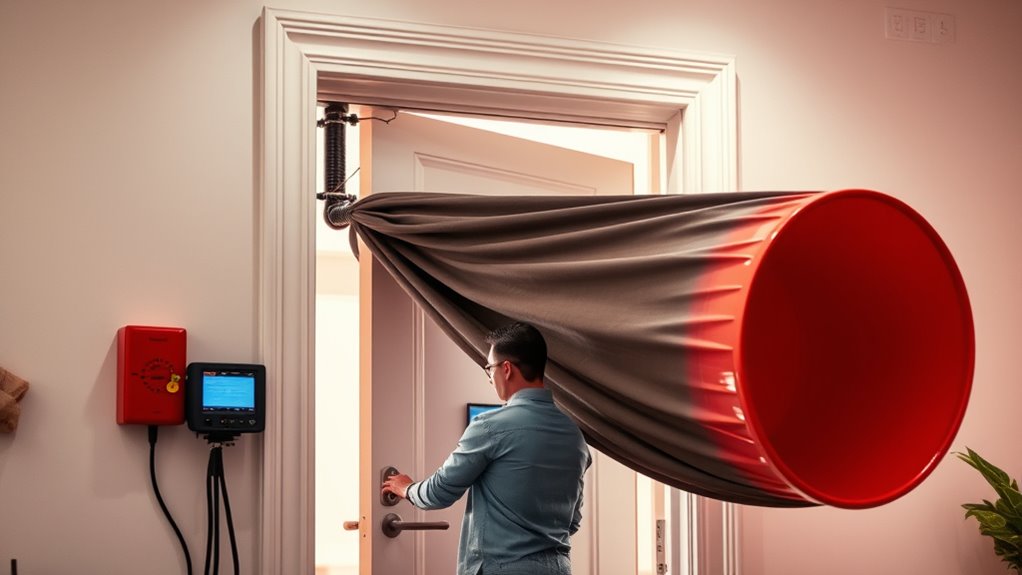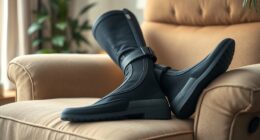Airtightness testing with a blower door helps you identify leaks that cause drafts, energy loss, and higher utility bills. During the test, a device is installed in an exterior doorway to create a pressure difference, which reveals how much air escapes through openings. Proper calibration of the equipment guarantees accurate results, guiding effective sealing strategies. If you want to understand how this process works and why calibration is key, keep exploring these essential steps.
Key Takeaways
- Airtightness testing evaluates a building’s ability to prevent drafts and energy loss via air leaks.
- Blower door testing uses a device to create a pressure difference, measuring airflow to identify leaks.
- Proper equipment calibration ensures accurate, reliable measurements and effective leak detection.
- Regular calibration of sensors and gauges is essential for consistent testing results.
- Using professional-grade equipment improves accuracy, compliance, and the effectiveness of sealing efforts.

Have you ever wondered how well your building keeps out drafts and maintains energy efficiency? One of the most effective ways to find out is through airtightness testing, and a key method used is blower door testing. This process helps you identify air leaks that can cause drafts, energy loss, and higher utility bills. To guarantee accurate results, air leakage diagnostics are essential, and that begins with proper testing equipment calibration. When your testing equipment is correctly calibrated, it provides reliable data, helping you pinpoint problem areas accurately. Without calibration, measurements can be off, leading to misdiagnosis of leaks or overlooking hidden issues.
During an airtightness test, a blower door device is installed in an exterior doorway. This equipment creates a pressure difference between the inside and outside of the building. By controlling and measuring this pressure, you can determine how much air escapes through the building envelope. The process involves sealing all other openings, such as windows and vents, to guarantee the test measures only the building’s envelope leaks. The testing equipment then blows air in or pulls air out, and sensors record the pressure and airflow. These readings reveal the building’s airtightness level, often expressed as air changes per hour (ACH) at a specific pressure, such as 50 Pascals.
Blower door testing measures building airtightness by creating and controlling pressure differences.
Accurate air leakage diagnostics rely heavily on proper equipment calibration. If the blower door’s sensors or flow meters aren’t calibrated correctly, the data collected won’t truly reflect the building’s performance. Regular calibration ensures that measurements are consistent and precise, reducing the chance of false readings. This is especially important when comparing results over time or verifying the effectiveness of air sealing efforts. Proper calibration also helps you meet industry standards and building codes, which often specify testing procedures and accuracy requirements.
In addition to calibration, understanding the nuances of testing equipment is vital. For example, the pressure gauges must be zeroed correctly, and the flow meters calibrated to manufacturer specifications. This attention to detail guarantees that your air leakage diagnostics are trustworthy. When you interpret the results, you’ll know exactly where leaks are located, whether around windows, doors, or in the building’s envelope itself. This information allows you to target sealing efforts more effectively, improving energy efficiency and indoor comfort.
Furthermore, using professional-grade equipment ensures the most accurate and reliable diagnostic results, which is crucial for effective building performance improvements. Ultimately, airtightness testing with properly calibrated equipment is a powerful tool. It not only helps you diagnose and locate leaks but also provides a benchmark for ongoing building performance. Guaranteeing your testing equipment is accurately calibrated means you can trust the results, making your efforts to improve building airtightness more effective and efficient.
Frequently Asked Questions
How Often Should Airtightness Testing Be Performed?
You should perform airtightness testing at least once during construction or renovation to meet building codes and guarantee energy efficiency. For new buildings, testing is often required before occupancy, while existing structures may need periodic testing depending on local regulations and performance goals. Regular testing helps identify leaks early, saving energy and costs. Always check your area’s testing frequency requirements, as they vary based on building type and jurisdiction.
What Are Common Causes of Air Leaks?
Common causes of air leaks include gaps or cracks in your building envelope, around windows, doors, and utility penetrations. Poorly sealed joints, damaged weatherstripping, and uninsulated areas also contribute to leaks. During leak detection, you might find leaks near attic hatches, vents, or where materials meet. Addressing these issues improves energy efficiency and indoor comfort by creating a more airtight building envelope.
Can Airtightness Testing Improve Energy Efficiency?
Absolutely, airtightness testing can profoundly boost your building’s efficiency. By pinpointing leaks in the building envelope, you can plug gaps that let heat escape and outdoor pollutants enter, enhancing indoor air quality. This process reduces energy waste, lowers utility bills, and creates a healthier, more harmonious home environment. So, sealing leaks with airtightness testing transforms your space into a more energy-efficient, eco-friendly haven.
What Equipment Is Used for Blower Door Testing?
You use specialized equipment like a blower door fan, manometers, and pressure gauges for blower door testing. Before testing, you verify the blower door is properly calibrated to meet testing protocols. The calibrated fan is installed in an exterior doorway, and you then measure the pressure difference to assess airtightness. Following testing protocols guarantees accurate results, helping you identify leaks and improve energy efficiency in the building.
How Does Climate Affect Airtightness Testing Results?
Climate dramatically impacts airtightness testing results—humidity impact and seasonal variations can make your tests wildly unpredictable. Hot, humid weather can cause moisture to seep into your building envelope, falsely indicating leaks, while cold, dry conditions can tighten seals and hide actual leaks. You must consider these climate factors to guarantee accurate readings, as seasonal shifts can lead to inconsistent results, making it essential to schedule testing during stable weather conditions for reliable data.
Conclusion
Remember, airtightness testing reveals how small leaks can lead to big energy losses. Just like a tiny crack can let in drafts, a single overlooked detail can undermine your home’s efficiency. While sealing up gaps might seem simple, it’s the foundation of comfort and savings. Don’t underestimate the power of small improvements—they’re the difference between a drafty house and a well-sealed sanctuary. Ultimately, precision in testing makes certain your home stays airtight, cozy, and cost-effective.









